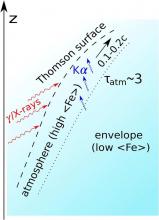
Abstract
Reverberation observations yielding a lag spectrum have uncovered an Fe K α fluorescence line in the tidal disruption event (TDE) Swift J1644+57. The discovery paper used the lag spectrum to argue that the source of the X-ray continuum was located very close to the black hole (∼30 gravitational radii) and moved subrelativistically. We reanalyse the lag spectrum, pointing out that dilution effects cause it to indicate a geometric scale an order of magnitude larger than inferred by Kara et al. If the X-ray continuum is produced by a relativistic jet, as suggested by the rapid variability, high luminosity and hard spectrum, this larger scale predicts an Fe ionization state consistent with efficient K α photon production. Moreover, the momentum of the jet X-rays impinging on the surrounding accretion flow on this large scale accelerates a layer of gas to speeds ∼0.1–0.2c, consistent with the blueshifted line profile. Implications of our results on the global picture of jetted TDEs are discussed. A power-law γ/X-ray spectrum may be produced by external ultraviolet (UV)–optical photons being repetitively inverse-Compton scattered by cold electrons in the jet, although our model for the K α reverberation does not depend on the jet radiation mechanism (magnetic reconnection in a Poynting jet is still a viable mechanism). The non-relativistic wind driven by jet radiation may explain the late-time radio rebrightening in Swift J1644+57. This energy injection may also cause the thermal UV–optical emission from jetted TDEs to be systematically brighter than in non-jetted ones.